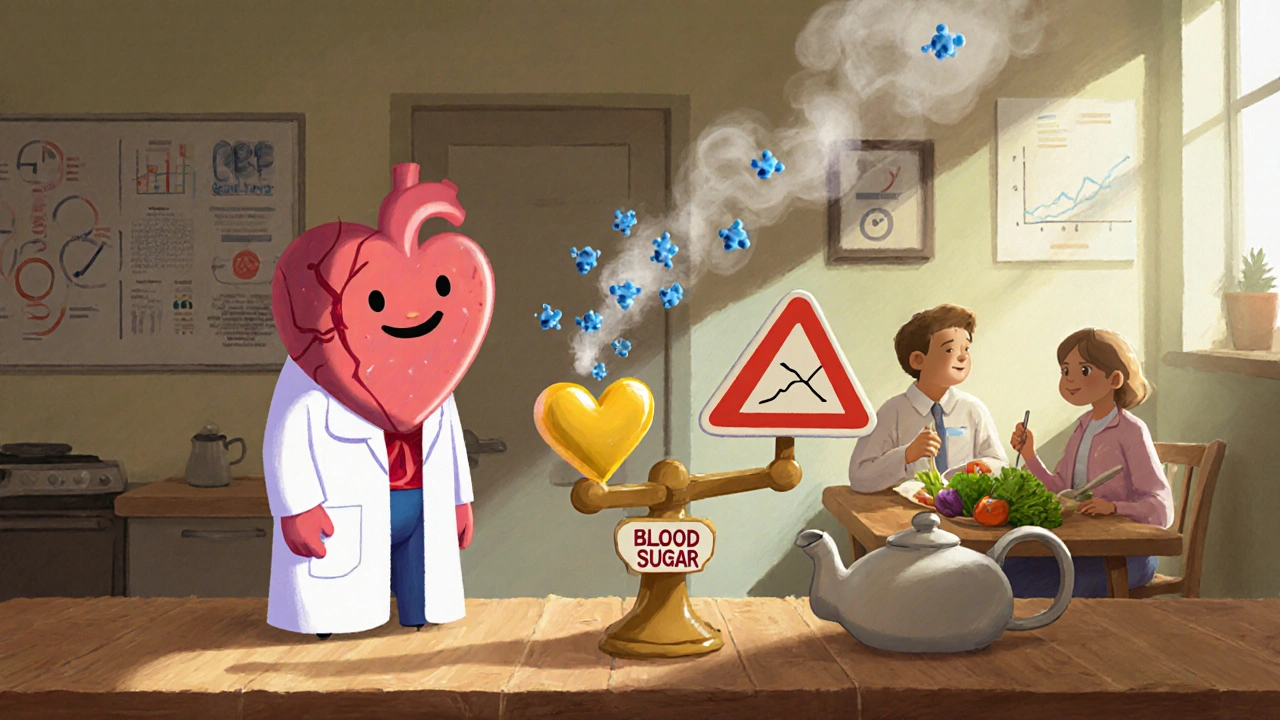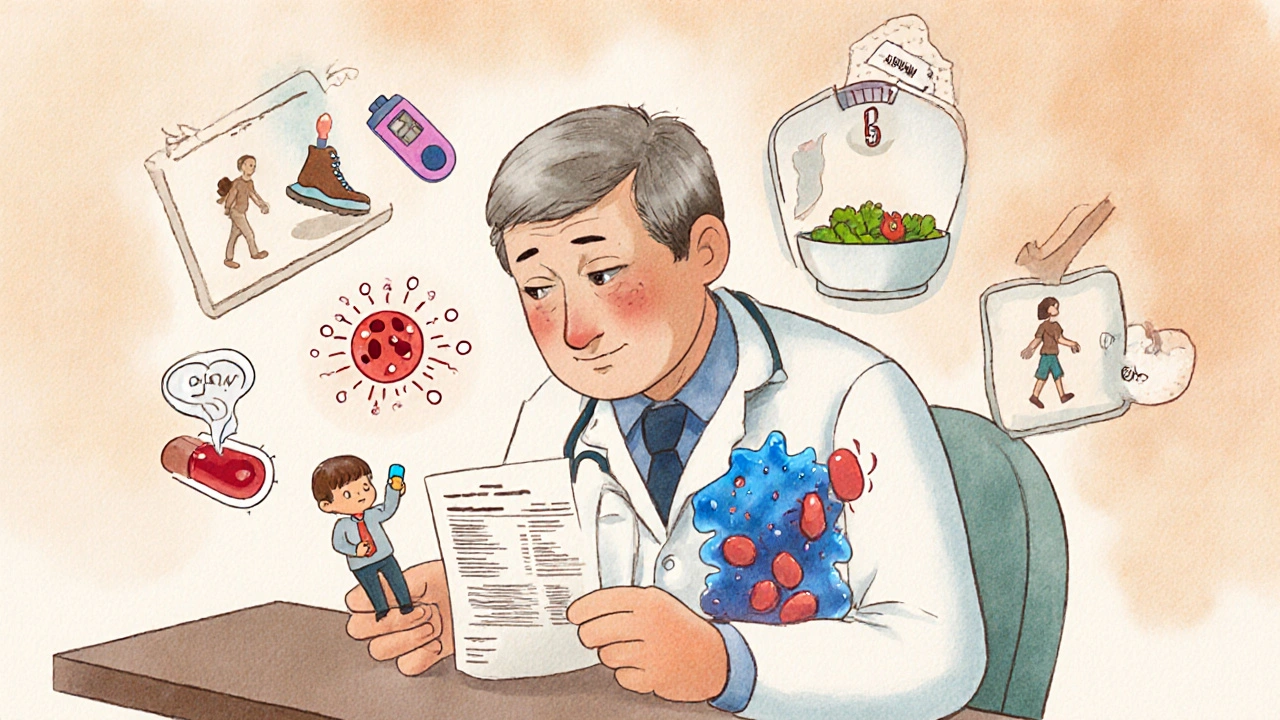Statins and Diabetes: How Statins Can Raise Blood Sugar in Some People
 Oct, 28 2025
Oct, 28 2025
Statin Blood Sugar Impact Calculator
How Statins Affect Your Blood Sugar
Statins can raise blood sugar levels, particularly in people with prediabetes or other risk factors. This calculator estimates your personal risk based on your statin type, dosage, and health profile.
Important: This tool provides general guidance only. Always discuss your specific situation with your healthcare provider before making any changes to your medication.
Your Personalized Risk Assessment
When you’re prescribed a statin, it’s usually because your doctor is trying to protect your heart. Statins lower cholesterol, reduce plaque in arteries, and cut your risk of heart attacks and strokes. But for some people, there’s a quiet side effect that doesn’t get talked about enough: statins can raise blood sugar levels.
This isn’t a myth. It’s not rare. It’s not something that only happens to people who eat too much sugar. Large, long-term studies - like the ones from Oxford Population Health and the NIH - have confirmed it. Statins don’t cause diabetes in most people. But for those already on the edge, they can push them over it.
How Statins Affect Blood Sugar
Statins work by blocking an enzyme in your liver that makes cholesterol. But that same enzyme is part of a bigger system - the mevalonate pathway - that also helps your body manage insulin and glucose. When statins interfere with this pathway, two things happen:
- Your muscles and fat cells become less sensitive to insulin. This means insulin can’t do its job properly, so sugar stays in your blood longer.
- Your pancreas struggles to release enough insulin to compensate. Over time, the cells that make insulin (beta cells) get stressed, especially if you’re already carrying extra weight or have prediabetes.
A 2023 study of nearly 9,000 people found that those on statins had a 46% higher chance of developing type 2 diabetes over six years. The reason? Insulin sensitivity dropped by 24%, and insulin production fell by 12%. That’s not a huge change - but for someone whose blood sugar is already hovering near the danger line, it’s enough to cross into diabetes territory.
The Dose Matters
Not all statins carry the same risk. It’s not about the drug name - it’s about how strong the dose is.
High-intensity statins - like atorvastatin (40-80 mg) or rosuvastatin (20-40 mg) - are linked to a 36% higher risk of new diabetes compared to placebo. Lower doses? Around 10% higher risk. That’s why doctors often start with the lowest effective dose, especially if you’re already at risk for diabetes.
Some studies suggest atorvastatin might have a slightly stronger effect on blood sugar than other statins, but the bigger factor is the dose. A 10 mg dose of atorvastatin is much safer than 80 mg. The same goes for simvastatin or pravastatin - if you’re on a low dose, your risk stays low.
Who’s Most at Risk?
If you’re wondering whether you’re in the group that might be affected, ask yourself these questions:
- Do you have prediabetes? (Fasting blood sugar between 100-125 mg/dL)
- Are you overweight, especially around your waist?
- Do you have high blood pressure or abnormal cholesterol (high triglycerides, low HDL)?
- Do you have a family history of type 2 diabetes?
- Are you over 65?
If you answered yes to two or more, you’re in the higher-risk group. That doesn’t mean you shouldn’t take statins - it means you need to be monitored.
People with metabolic syndrome - a mix of belly fat, high blood pressure, insulin resistance, and bad cholesterol - are especially vulnerable. Their bodies are already struggling to manage sugar. Adding a statin can tip the balance.

What Happens to People Who Already Have Diabetes?
If you already have type 2 diabetes, statins can make your blood sugar harder to control. Research shows that on higher doses, your HbA1c - a three-month average of blood sugar - can rise by 0.3% to 0.5%. That might not sound like much, but for someone trying to keep HbA1c under 7%, it can mean needing more medication or adjusting your diet.
Some patients report needing to increase their metformin dose or start insulin after beginning a statin. It’s not universal - many people with diabetes take statins without any issues - but it’s common enough that doctors should check blood sugar levels before and after starting statin therapy.
The Bigger Picture: Benefits vs. Risk
This is where people get scared. If statins raise blood sugar, should you avoid them?
Let’s put it in numbers.
For someone with high cholesterol and a 10% risk of a heart attack in the next 10 years, taking a statin lowers that risk by about 1.5% over five years. That’s 15 out of 1,000 people who avoid a heart attack or stroke.
Over the same time, about 1 to 2 out of those 1,000 might develop diabetes because of the statin.
That’s a 7-to-1 benefit-to-risk ratio. And for people who’ve already had a heart attack, the benefit is even bigger.
The American Heart Association, the American Diabetes Association, and the CDC all agree: statins save more lives than they harm. The rise in blood sugar is real, but it’s small - and often manageable.

What You Can Do
If you’re on a statin and worried about blood sugar, here’s what actually helps:
- Get tested. Ask your doctor for a fasting glucose test and an HbA1c test before starting the statin, and again in 3 to 6 months.
- Move more. Just 30 minutes of brisk walking five days a week improves insulin sensitivity more than any supplement. Exercise helps your muscles use sugar without needing as much insulin.
- Eat smarter. Cut back on sugary drinks, white bread, and processed snacks. Focus on vegetables, whole grains, lean protein, and healthy fats. A Mediterranean-style diet has been shown to reduce statin-related blood sugar spikes.
- Watch your weight. Losing even 5% of your body weight can reverse prediabetes. That’s 10 pounds for someone who weighs 200.
- Don’t stop your statin. If your blood sugar goes up, talk to your doctor. They might adjust your dose, switch you to a different statin, or add a medication like metformin - but stopping the statin without a plan puts your heart at risk.
What About Alternatives?
Some people ask: Are there other cholesterol-lowering drugs that don’t raise blood sugar?
Yes - but they’re not better.
Ezetimibe lowers cholesterol but doesn’t reduce heart attacks as much as statins. PCSK9 inhibitors (injections like evolocumab) are very effective but cost $14,000 a year. Fibrates and niacin don’t offer the same protection. Right now, statins are still the gold standard.
Researchers are working on new versions of statins that lower cholesterol without affecting glucose metabolism. A 2023 study in Nature Medicine found that people with certain genetic markers (like variations in the SLCO1B1 gene) are more likely to develop diabetes on statins. In the future, a simple blood test might tell your doctor which statin is safest for you.
Bottom Line
Statins can raise blood sugar - but only in a small group of people who are already at risk. For most, the heart protection they offer is worth the trade-off. If you’re concerned, don’t stop the medication. Talk to your doctor. Get tested. Make small lifestyle changes. You don’t have to choose between your heart and your blood sugar. You can protect both.
Do all statins raise blood sugar?
Not all statins affect blood sugar the same way. High-intensity statins like atorvastatin and rosuvastatin carry a higher risk, especially at higher doses. Lower-intensity statins like pravastatin and fluvastatin have less impact. But the dose matters more than the brand. Even a low-dose high-intensity statin can raise blood sugar more than a high-dose low-intensity one.
Can I avoid diabetes by switching statins?
Sometimes, switching to a statin with a lower risk profile - like pravastatin or fluvastatin - can help. But the best approach is usually to lower the dose first, then consider a switch. If you’re on 80 mg of atorvastatin and your blood sugar is rising, going down to 20 mg might be enough to control cholesterol without pushing you into diabetes. Never switch without medical advice.
How long does it take for statins to raise blood sugar?
Changes in blood sugar can show up within 3 to 6 months of starting a statin. That’s why doctors recommend checking fasting glucose and HbA1c before you start and again after 3 to 6 months. If your numbers are stable after a year, the risk of future spikes drops significantly.
Does stopping statins reverse the diabetes risk?
In some cases, yes. If you develop prediabetes from a statin and then stop taking it, your blood sugar can return to normal - especially if you’ve made lifestyle changes. But if you’ve already developed full type 2 diabetes, stopping the statin won’t cure it. The damage to your insulin-producing cells may be permanent. That’s why stopping statins should only be done under medical supervision.
Should I take metformin with my statin to prevent diabetes?
For people with prediabetes who are starting a high-intensity statin, some doctors do prescribe metformin as a preventive step. It’s not standard for everyone, but if you’re at high risk - obese, with prediabetes and high blood pressure - metformin can help protect your pancreas and improve insulin sensitivity. Talk to your doctor about whether this makes sense for you.

Bob Martin
October 29, 2025 AT 14:36So let me get this straight - we’re giving people heart drugs that might turn them into diabetics so they don’t die of a heart attack but might need insulin instead? Cool cool cool. At least the pharma bros are getting their cut.
Sage Druce
October 30, 2025 AT 02:09Look I get it - statins save lives. But if you’re already borderline diabetic and your doctor just hands you a script without talking about diet or movement, that’s not care - that’s convenience. You can’t pill your way out of a lifestyle crisis. Start with walking. Start with water. Start with listening to your body. It’s not magic. It’s just basic.
Tyler Mofield
October 30, 2025 AT 20:19Statins inhibit HMG-CoA reductase thereby reducing cholesterol biosynthesis via the mevalonate pathway which indirectly impairs insulin signaling through diminished prenylation of small GTPases such as Rho and Rac. This results in decreased GLUT4 translocation and beta-cell dysfunction. The benefit-risk calculus remains favorable for secondary prevention. End of discussion.
Patrick Dwyer
November 1, 2025 AT 18:11For anyone worried about this - you’re not alone. But you’re not powerless. Talk to your doctor. Get your numbers checked. Move your body. Eat real food. You don’t need to be perfect. Just consistent. Statins aren’t the enemy. Ignorance is. You’ve got this.
Bart Capoen
November 2, 2025 AT 13:35my doc put me on 20mg atorva after my stent. 6 months later my fasting sugar went from 98 to 118. didn’t panic. switched to pravastatin 40mg. sugar back to 95. no drama. point is - dose and type matter. don’t just roll with whatever they hand you. ask questions. it’s your body.
luna dream
November 2, 2025 AT 15:50Statins were designed by the medical-industrial complex to keep you dependent. The real cause of heart disease? Sugar. Corn syrup. Government subsidies. The FDA is in bed with Big Pharma. They don’t want you to know that statins are just a Band-Aid on a bullet wound.
Linda Patterson
November 3, 2025 AT 23:05Other countries don’t have this problem. America’s obesity epidemic is why this happens. If you weren’t so lazy and ate real food like in Japan or Italy you wouldn’t need statins or insulin. Take responsibility. Stop blaming pills.
Jen Taylor
November 4, 2025 AT 21:04I was terrified when my HbA1c crept up after starting rosuvastatin… but then I started eating more leafy greens, walking after dinner, and cutting out soda. My numbers dropped back down - and I felt better than I had in years. It’s not about choosing between your heart and your pancreas. It’s about choosing to care - for both.
Shilah Lala
November 5, 2025 AT 01:28So what you’re saying is… the cure is worse than the disease? And we’re supposed to be grateful? Wow. Just wow. I’ll take my chances with a heart attack over a lifetime of glucose monitors and metformin side effects. Thanks, science.
Christy Tomerlin
November 5, 2025 AT 23:46Why not just take fish oil? Or garlic? Or whatever that guy on YouTube says works? Statins are overrated. People get scared of cholesterol like it’s a monster. It’s just a molecule. Chill.
Lorena Cabal Lopez
November 7, 2025 AT 16:46Another article telling people what to do. Nobody asked for this. I’m tired of being told I’m at risk. I’m just trying to survive.
Stuart Palley
November 9, 2025 AT 12:19My dad died of a heart attack at 58. He refused statins because he read this exact post on Reddit. He didn’t even know his own numbers. Now I’m on one. And I check my sugar every week. I’d rather live with a little extra glucose than die like him. Don’t be stupid. Talk to your doctor.